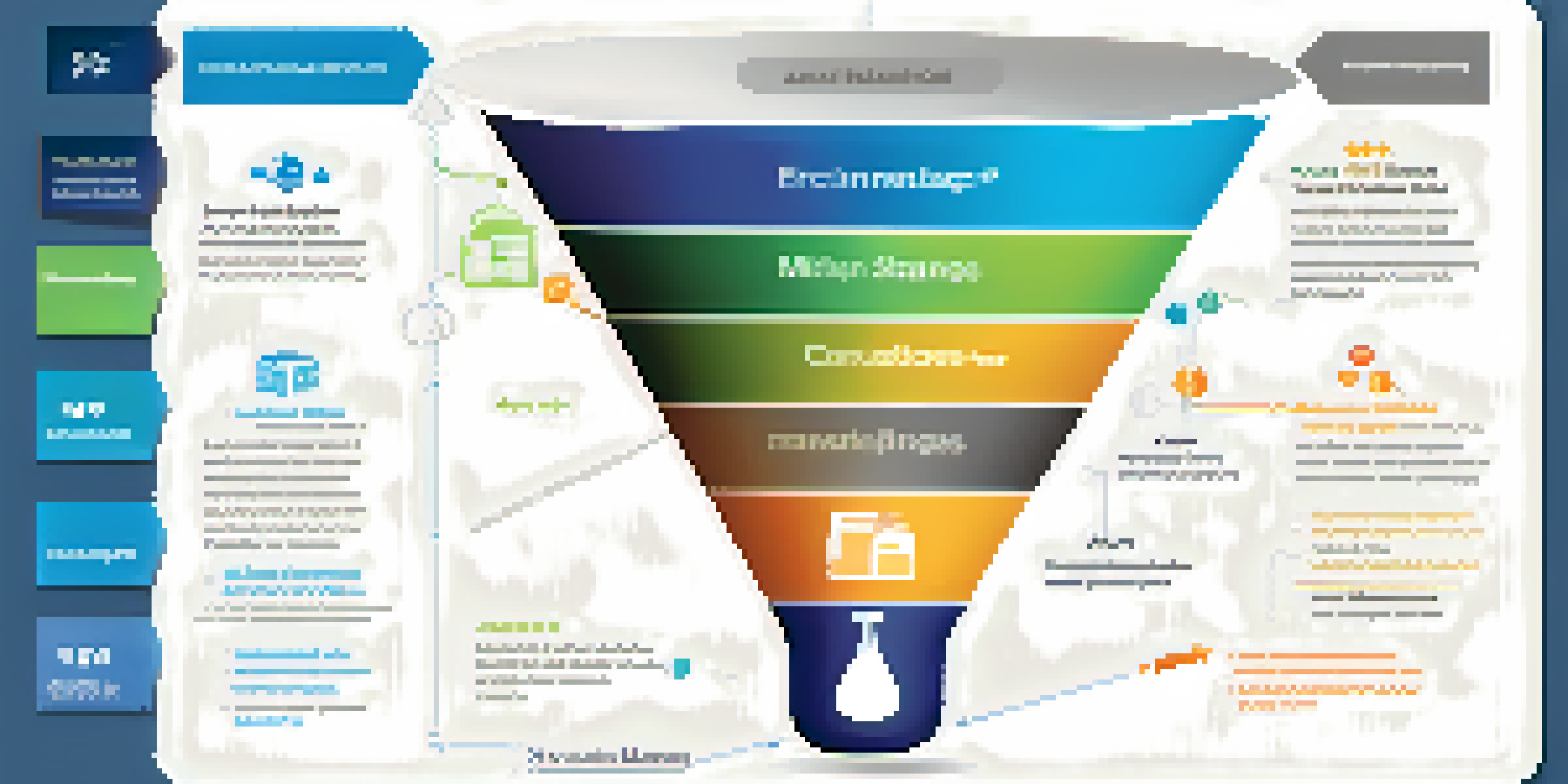Identifying Bottlenecks in Your Sales Funnel Process

Understanding the Sales Funnel and Its Stages
The sales funnel is a visual representation of the customer journey, from awareness to purchase. It consists of several stages, including awareness, consideration, and decision. Each stage represents a step that potential customers take before making a purchase.
You can't improve what you don't measure.
Understanding each stage is crucial for identifying where potential customers drop off. For instance, if many visitors leave during the consideration stage, it might indicate that your product’s value isn’t being communicated effectively. This understanding can help you focus your efforts on the most problematic areas.
By visualizing the sales funnel, you can better analyze how effectively you’re guiding customers through each stage. This clarity is essential for spotting inefficiencies or bottlenecks that impede conversions.
Common Signs of Bottlenecks in Your Funnel
Bottlenecks often manifest as sudden drops in conversion rates at specific stages of the funnel. For example, if you notice a high number of website visitors but a sharp decline in sign-ups, this could signal a bottleneck. Recognizing these signs is the first step toward resolution.

Another common indicator is customer feedback; if potential buyers express confusion or frustration about your product offerings, this may point to unclear messaging or a complicated purchasing process. Pay attention to what your audience is saying, as their insights can guide you to the root of the problem.
Understand Your Sales Funnel Stages
Recognizing each stage of the sales funnel helps identify where potential customers drop off.
Lastly, analyzing your analytics can help reveal bottlenecks. Look for any significant discrepancies in engagement metrics, such as a high bounce rate on landing pages, which could indicate that something isn’t resonating with your audience.
Analyzing Your Sales Data for Insights
Data analysis is essential for understanding bottlenecks in your sales funnel. Tools like Google Analytics provide valuable insights into user behavior, allowing you to track how visitors interact with your site. By examining this data, you can pinpoint exactly where customers are losing interest.
The best way to predict the future is to create it.
For example, if you see a high drop-off rate at the checkout stage, this could indicate complications in the payment process or unexpected shipping costs. Identifying these issues through data can empower you to make informed adjustments that streamline the customer experience.
Regularly reviewing your sales metrics not only helps identify bottlenecks but also reveals trends that can inform your marketing strategies. This proactive approach ensures you’re always refining your process for better results.
Conducting Customer Surveys for Direct Feedback
One of the most effective ways to identify bottlenecks is by asking your customers directly. Customer surveys can provide insights into their experiences and frustrations along the buying journey. Tailor your questions to uncover specific issues they may have encountered.
For instance, you might ask customers why they decided not to complete a purchase or what information they felt was missing to make a decision. Their answers can highlight areas for improvement that you may not have considered.
Identify and Resolve Bottlenecks
Spotting signs of bottlenecks, such as sudden drops in conversion rates, is crucial for improving the customer journey.
By engaging with your audience this way, you not only gather valuable feedback but also show that you value their opinions. This engagement can foster customer loyalty and improve overall satisfaction.
Testing and Optimizing Your Funnel Stages
Once you’ve identified potential bottlenecks, it’s time to test different solutions. A/B testing is a powerful method for determining what changes work best. For example, you could test different call-to-action buttons or landing page designs to see which performs better.
This iterative process allows you to make data-driven decisions rather than relying on guesswork. By continuously optimizing your funnel stages, you can enhance the user experience and boost conversion rates.
Remember, optimization is an ongoing process. What works today might not work tomorrow, so be prepared to adapt and refine your strategies as market conditions and customer preferences evolve.
Leveraging Automation to Streamline Processes
Automation can be a game changer in reducing bottlenecks within your sales funnel. Tools like email marketing automation can help nurture leads more efficiently, keeping potential customers engaged without overwhelming your team. This ensures timely follow-ups and personalized communication.
For instance, setting up automated email sequences for abandoned carts can encourage customers to return and complete their purchases. This simple step can significantly reduce drop-offs at the critical checkout stage.
Continuous Funnel Optimization Needed
Regularly reviewing and refining your sales funnel ensures it adapts to changing market conditions and customer behaviors.
By leveraging technology to automate repetitive tasks, you can free up your team to focus on higher-level strategies, thus improving overall productivity and efficiency.
Regularly Reviewing and Refining Your Sales Funnel
Identifying and addressing bottlenecks is not a one-time task; it requires regular review and refinement. Schedule consistent evaluations of your sales funnel to ensure it remains effective as your business grows and market conditions change. This proactive stance can help you stay ahead of potential issues.
Keep an eye on key performance indicators (KPIs) relevant to your funnel stages. Regularly tracking these metrics will enable you to spot trends and shifts in customer behavior, allowing you to make timely adjustments.

Ultimately, a well-maintained sales funnel can lead to increased conversions and customer satisfaction. By committing to continuous improvement, you not only enhance your sales process but also build stronger relationships with your audience.